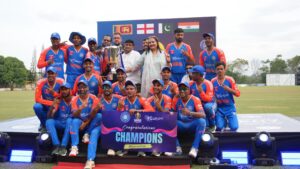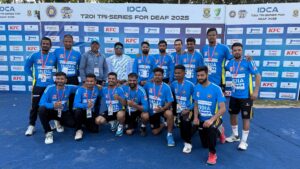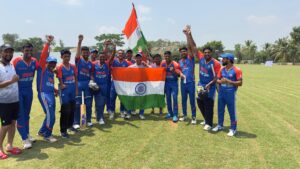
As we prepare for the much-awaited England-India five-match Test series, along with the women’s series, there is another Indian cricket team that will soon be playing a series with England. For the first time ever, England and India are playing a seven-match T20I series in the mixed-disability format. The Vitality IT20 Mixed Disability Series is a first of its kind in international cricket, bringing together three formats of disability under one umbrella — Physical Disability, Intellectual Disability and Hearing-and-Sight-impaired formats.
The tournament is designed in the format of England’s domestic Disability Premier League.
The first match of the series is being played at Taunton on June 21 while the final match will be in Bristol on July 3. The most attractive game of the series is to be played on June 25, at the iconic Lord’s.
To understand the format more and understand the disability cricket ecosystem in depth, RevSportz spoke to Mr Ravi Chauhan, General Secretary, Differently Abled Cricket Council of India (DCCI).
The team leaves on June 15, with a squad of 18 players — six from the physical disability category, six from deaf-and-mute category and four from the Intellectual Disability (ID) category.
People might be aware of the physical and hearing impairment categories, however the ID one in cricket is new for India. According to the DCCI, in Intellectual Disability, the criteria are that the athlete will have to have an IQ less than 75, have significant limitations on adaptive behaviour, including conceptual, social and practical skills, and the diagnosis of the impairment has been done before the age of 22.
Here’s how the conversation went with Chauhan on the upcoming series.

Departure and Team Composition
We’re leaving on the 15th of June. This is the first-ever Mixed Disability Cricket Series between India and England. The biggest thing is that this format is new for us. England has been playing it for a while now, but our players play cricket all year round too, so there’s no need to worry. We’ve got six deaf-and-mute players, six physically disabled players, and four with intellectual disabilities in the squad.
Finding Intellectually Disabled Players
This is the first time intellectual-disability cricket is happening in India, so getting the players was a big challenge. We didn’t know where to even find them—where do you look for players with intellectual disabilities who can play cricket? Because this is proper cricket—we use the same bat, same ball, same pitch, same ground as everyone else. Special Olympics Bharat helped us out. We did trials with their kids in Jaipur, some in Haryana, some in Greater Noida. We found players from there. We also got one player through the Intellectual Disability Sports Association, which participates in the Paralympics. It’s a new format for us, but it’s an incredible platform for the game.
Where are the players from?
You asked where the players are from—so we’ve got boys from Haryana, Delhi, Mumbai, Karnataka, Madhya Pradesh, Uttar Pradesh, and even Kashmir. They’re from across India. And the good thing is, they’re not new to the game—they’ve been playing for years in the physical disability and blind category. The ID category might be new for us, but we’re working hard.
Playing at Lord’s – A Dream
Honestly, I never imagined—even in my dreams—that these kids would play at Lord’s. But that was our mission, that they should get the chance to experience Lord’s one day. We’re playing a match at Bristol as a double-header—before the India vs England women’s match. There’s nothing bigger than that — not only for me, but for the country.

If you talk to a family who have a divyang (differently abled) child, you’ll know the kind of struggles they’ve gone through. But since the para-sports movement has picked up in India, our contingent has been doing incredibly well, winning medals. So why shouldn’t cricket also rise to that level? That’s our goal.
Coaching and Support Staff
We’ve taken complete care of the team. The head coach is Mr. Rohit Jalani—he’s a former captain of Rajasthan’s Ranji team. He’s been with us throughout. We’ve also got a conditioning and strengthening coach. A physiotherapist is with us.
A video analyst is travelling too. And for the players with intellectual disabilities, we’ve arranged for special care—so they feel completely comfortable. We’ve tried to match the same standards of international teams, even in terms of support staff.
Support from BCCI, ICC, and ECB
Let me be honest—if disability cricket has reached this stage, where we’re going to England now, a lot of credit goes to Mr Jay Shah. When he was appointed as BCCI’s Honorary Secretary, we met him. He told us—make an umbrella organisation, and we’ll support you. Today, BCCI stands fully behind us.
When the ECB proposed this format at the ICC AGM in Sri Lanka, all Test nations said yes, they’ll support it. So, this is the first mixed-disability series, and ICC wants to see how it goes between India and England. Then they’ll scale it globally. ECB reached out to BCCI, and BCCI asked our body—DCCI—to take it forward. All this was only possible because of BCCI’s backing. Jay Shah’s vision was to give our disabled cricketers the same pride and opportunity as anyone else. If he hadn’t supported us personally, we wouldn’t have come this far.
For the Latest Sports News: Follow RevSportz

Towards Paralympics and Global Recognition
I’ve been watching disability cricket in India for 40 years—it was played separately in different formats, tennis ball, rubber ball, and so on. Now it’s happening properly. The important thing now is to expand it to more countries. Right now, it’s played in only about 10–12 nations. In some countries, disabled kids don’t even survive, or the cases are very low, or there’s no funding.
That’s why we created the mixed format—because in some countries, you might not find enough physically disabled players, but you might find more deaf or intellectually challenged players. So, combining them allows the game to grow. In Asia, for example, there are still more polio-related disabilities than in Europe. This mixed format makes global participation possible.
Cricket is already in the Asian Games, and it’s being added to the Olympics. Our next goal is to approach the Paralympic Committee—via ministries, through the International Paralympic Committee (IPC)—so at least an exhibition match can be held. Even if full inclusion doesn’t happen yet, the world will see that this version of cricket is also played at a very high level.
Corporate Sponsorship and Struggles
Getting corporate sponsors is a constant challenge. IPL is going on, all the money is tied up there. Every state has its own league too. But we’re grateful to a few loyal sponsors who stand with us every time. Like Svayam, which works on accessibility—Mrs Sminu Jindal is always there for us.
ONGC supported our Sri Lanka tour, and we’re hoping they’ll step in again. Awareness is definitely growing. And ever since BCCI’s support came in, the struggle has reduced a bit. Earlier, we used to really struggle for even basic needs. Now things are changing. Yes, sports will always have challenges, but it’s getting better. I believe after this series, many more people and brands will come forward.

Playing Rules and Format
You asked about the format—whether there’s a fixed ratio in the playing XI. Yes, every category must have at least 3 players in the XI. So, if you have 4 intellectually disabled players in the squad, 3 must play. Same with physical disability—3 are mandatory. Deaf and mute—3 must play. The remaining two can be from any category. That’s how the mixed format works. I feel our strength is quite good. England may have stronger intellectually disabled players, but in deaf-mute and physical disability categories, we’re stronger.
Message to Fans and Media
I want to say this to all Indians—and especially Indians living in the UK—please support these boys just like you support the men’s and women’s national teams. They’re using the same ball, same bat, same helmet, same ground. When you watch them play, you’ll feel proud. They’re our real heroes. If you support them, they’ll get that motivation to keep pushing.
To families who have divyang children—this is your dream coming true. Maybe your abled child couldn’t become a cricketer, but your differently abled child is now walking into Lord’s carrying the Indian flag. That’s no small thing.
And to the media—I request you, those of you covering the women’s Test or men’s matches—please cover these kids too. Media plays a huge role. When you write about them, the world will know where disability cricket in India has reached. So please stay with us on this journey.
Also Read: Janusz Kusociński Memorial 2025: Neeraj Chopra Takes Second Spot Once Again